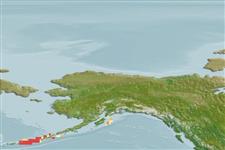Classificatie / Names
Lokale namen | Synoniemen | Catalog of Fishes(Genus, Soort(en)) | ITIS | CoL | WoRMS | Cloffa
>
Perciformes/Zoarcoidei (Eelpouts and pricklebacks) >
Zoarcidae (Eelpouts) > Lycodinae
Etymology: Lycodes: Greek, lykos = wolf + Greek, suffix, oides = similar to (Ref. 45335); akuugun: Named after the Aleut name for the native inhabitants of the Islands of Four Mountains, the region where the species was discovered; noun in apposition..
Environment: milieu / climate zone / depth range / distribution range
Ecologie
marien demersaal; diepte 121 - 460 m (Ref. 56970). Temperate
Northeast Pacific: Aleutian Islands.
Grootte / Gewicht / Leeftijd
Maturity: Lm ? range ? - ? cm
Max length : 32.4 cm SL mannelijk / geslacht onbekend; (Ref. 56970)
Korte beschrijving
Determinatiesleutels | Morfologie | Morfometrie
Dorsale zachte stralen (totaal) : 107 - 120; Anale zachte stralen: 97 - 103; Wervels: 113 - 120. Diagnosis: Distinguished from the majority of its congeners (46 of 61 currently recognized species) by the ventral position of the lateral line. Among species of Lycodes with a ventral lateral line, the new species is distinguished from brevipes, diapterus, hubbsi, microporus, nakamurae, nishimurai, and ocellatus by the absence of scales on the nape. It is distinguished from all remaining congeners except pectoralis and vahlii by its comparatively high vertebral count (113-120 vs. 94-113 in brunneofasciatus, caudimaculatus, frigidus, gracilis, and obscurus). It is distinguished from pectoralis and vahlii by the presence of an interorbital pore, number of anal-fin pterygiophores preceding the first haemal spine (5-7 vs. 2-4), and the color pattern (pectoralis and vahlii lack light bands on the dorsal fin, light blotches on the upper body, and the bicolor appearance of the head, body, and pectoral fin) (Ref. 56970).
The species were collected in hauls dominated by Atheresthes stomias, Theragra chalcogramma, Hippoglossus stenolepis, and Sebastes alutus; also with Lycodes diapterus and L. concolor. Bottom temperatures of collection sites ranged from 3.3-4.3 °C. Stomach contents of 2 specimens has partially digested sea urchin tests (Ref. 56970).
Levenscyclus en paargedrag
Maturities | Voortplanting | Spawnings | Egg(s) | Fecundities | Larven
Stevenson, D.E. and J.W. Orr, 2006. A new species of Lycodes (Perciformes: Zoarcidae) from the Aleutian Islands. Copeia 2006(1):77-82. (Ref. 56970)
Status op de Rode Lijst van het IUCN (Ref. 130435)
Gevaar voor de mens
Harmless
Gebruik door de mens
Tools
Speciale rapporten
Download XML
Internetbronnen
Estimates based on models
Preferred temperature (Ref.
123201): 3.7 - 4.5, mean 3.9 °C (based on 6 cells).
Fylogenetische diversiteitsindex (Ref.
82804): PD
50 = 0.5000 [Uniqueness, from 0.5 = low to 2.0 = high].
Bayesian length-weight: a=0.00120 (0.00057 - 0.00252), b=3.10 (2.91 - 3.29), in cm total length, based on LWR estimates for this (Sub)family-body shape (Ref.
93245).
Trofisch niveau (Ref.
69278): 3.4 ±0.5 se; based on size and trophs of closest relatives
Weerstandsvermogen (Ref.
120179): laag, minimale populatieverdubbelingstijd 4,5-14 jaar (Preliminary K or Fecundity.).
Fishing Vulnerability (Ref.
59153): Low to moderate vulnerability (30 of 100).
